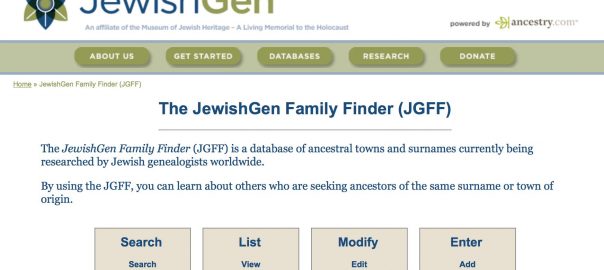In 1991 two pioneers of Jewish genealogy, Arthur Kurzweil and Miriam Weiner, published the first volume of what was supposed to be a continuing series, The Encyclopedia of Jewish Genealogy, Volume 1: Sources in the United States and Canada. I don’t know how long it was in print. I have never read the book, so I cannot even tell you what is inside it, but as it pre-dates the Internet (or at least the public Internet that we all know today), it presumably deals with the archives and resources available in North America that one needed to visit in person to do family research.
I actually own other books that both Arthur Kurzweil and Miriam Weiner have published separately. The fact that Arthur Kurzweil’s From Generation to Generation is still in print after being originally published in 1980 illustrates its importance. Amazon tells me I bought a copy in 2009. I own both of Miriam Weiner’s Jewish Roots books – Jewish Roots in Poland and Jewish Roots in Ukraine and Moldova. I probably bought Jewish Roots in Poland around the same time, as I recall Jewish Roots in Ukraine and Moldova was already out of print and hard to find, and I see I was looking for a copy in 2010. After posting to a local genealogy group here in Israel, a generous person who no longer wanted the book gave me her copy. Weiner’s Jewish Roots books formed the basis of her Routes to Roots archive database. She later added information on Lithuania and Belarus as well, although only online.
It was in fact when I was corresponding with Miriam Weiner about her Routes to Roots archive database, that she mentioned her and Arthur Kurzweil’s book as having the same name as my site.
My first response was, frankly, terror. Putting aside that I had not known about a book by two important Jewish genealogists of whom I have an incredible amount of respect, and that I had used more or less the same name for my site, the thought of changing over 17,000 web pages was more than I could think about. While there is something to be said that the name is fairly generic, and I had always prepended B&F before Encyclopedia of Jewish Genealogy, after a night’s sleep I realized I could figure out how to change the site and the name, and there was no reason to keep the name if there was even the slightest chance it might cause confusion.
It’s not like I make money from the site, or have any kind of advertising for it. I never sold t-shirts with the logo, or otherwise put the name into print. My goal has always been first and foremost to help people, and I don’t need to keep a specific name to help people.
There are actually a limited number of words in the English language that convey a similar meaning to encyclopedia. At first I thought of almanac, although it connotes a connection to the calendar. Last year I had originally wanted to use the archaic word cyclopedia, of which I own the Century Cyclopedia of Names, but I opted for encyclopedia as clearer, and now it would be too close. While dictionary is sometimes used outside its word-defining purpose, it seemed wrong to me. To me that left only compendium, which is a collection of things, and could cover the large collection of resources I have organized.
Interestingly enough the word compendium is used in the title of a book by another Jewish genealogy pioneer – Malcolm Stern’s 1960 book Americans of Jewish descent; a compendium of genealogy. Then again, his title has similarities to the earlier The Compendium of American Genealogy, First Families of America (1925–1942) by Frederick Adams Virkus. In any case, there are only so many words, and I think this is different enough to be okay.
I managed to find a way to automatically (automagically?) change the URLs of the site (more than 17,000 of them), and I tried my best to change references on the site from Encyclopedia to Compendium. I obviously can’t change links on other sites that link to my site, however, if someone goes to an old link, the site will automatically change it to the new link. If you end up going to a page only to get an error message, let me know.
Please enjoy the B&F Compendium of Jewish Genealogy.









